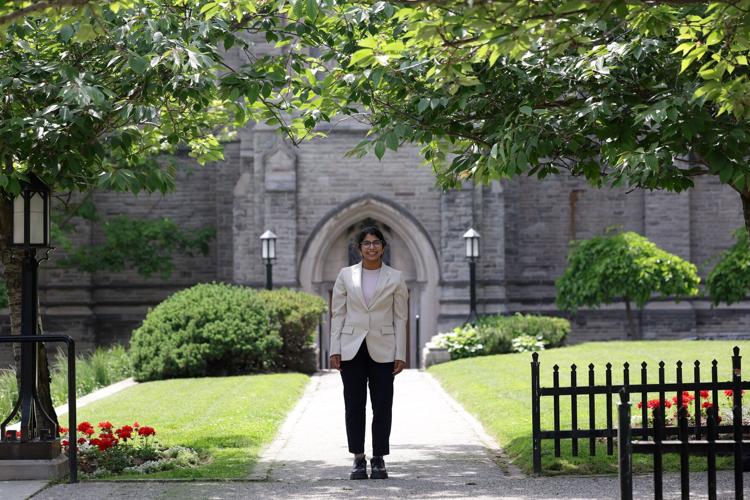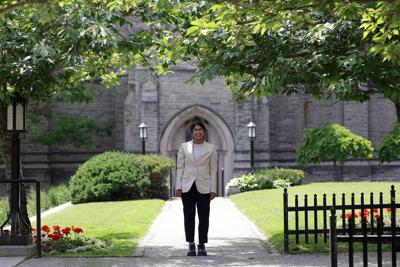For the first two years of high school, Nuha Zawahir missed a dreaded, often criticized but traditional rite of passage: the final exam.
The Unionville teenager was in the first cohort of students to start Grade 9 in the pandemicÌęâ as Ontario was entering only its second wave. She, like the rest of this provinceâs soon-to-be graduating class of 2024, lost formative experience when school boards put a pause on exams.
âI was so worried,â says the now-Grade 12 student at Markham District High School. âWe werenât cultivating skills,â like proper study habits or even building up the staminaÌęto sit and think critically for hours.
She had her first exam in Grade 11. âTo start right then and there, it was a bit of a learning curve.â
But even as exams returned for Ontarioâs nearly 650,000 public high school students, concerns over the formatâs flaws intensified â chief among them that they rely on memorization and reveal only a snapshot of knowledge.
Fostering a love of learning is the goal behind the âungradingâ movement, one that has garnered growing interest among educators.
Fostering a love of learning is the goal behind the âungradingâ movement, one that has garnered growing interest among educators.
The pandemicâs disruptive force had accelerated experimentation in assessmentâŻâ from ”ungrading” to pass-fail options toâŻâŻâ as educators sought out more humane and effective ways to measure achievement.
With teaching and learning having evolved to include more feedback and iteration, educators questioned whether the traditional, high-stakes final exam still had worth.
The answer has been a thorny one for Simcoe County District School Board, which, in attempting to do something different coming out of the pandemic, left its current crop of Grade 12 students without having ever done a formal, multi-hour, end-of-term exam. The changes sparked a petition, a protest and heated board meeting exchanges, and while the board recently responded with a compromise, the resistance illustrates how invested people are when you tinker with tradition.
Detractors of traditional exams claim they are âtoo anxiety-provoking for students, theyâre not an authentic measure of what they know,â says Louis Volante, distinguished professor of educational studies at Brock University.
âAll of those arguments have some validity to them, but they fail to recognize one important truism in all of this: which is at the end of the day, when those students go from Grade 12 to university, theyâre going to face exams, so how are we doing those students any favours by eliminating them?â
Last semester, when Zawahir had finals in advanced functions, chemistry and biology, she was âsuper stressed,â feeling like every mark counted. Now, with an offer in hand to study life sciences at the University of Toronto, sheâs heading into her final assessments feeling relievedâŻâ and thankful for having gone through the experience.
âIâm looking into a career in health care, and there are going to be times when Iâm going to have to study for big exams.â
Alternatives to final exams
There is no rule that Ontario students must take exams. TheâŻâŻgive teachers latitude to employ any kind of final assessment as long as it makes up 30 per cent of a final grade and allows students to demonstrate their comprehensive knowledge of a course.
For visual art, that might mean a portfolio of work; for music, a solo performance; for science, a lab. Teachers can break down the 30 per cent into multiple, less weighty parts.
âThere is no expectation that a course must have an exam,â says a spokesperson from York Region District School Board. âHow a studentâs learning will be demonstrated is determined collaboratively by the course and department teachers.â
The pc28čÙÍűDistrict School Board told the Star that while exams remain an element of assessment, they are ânot meant to be the sole and/or predominant method of evaluation experienced by students.â Educators are free to display âcreativity and innovation,â and âusing the tenets of culturally responsive pedagogy and decolonization ... identify alternatives to traditional exams when developing assessment opportunities.â
A handful of Ontarioâs 72 district school boards have even dropped the word âexamâ from their official calendars, opting to describe evaluations as âsummativeâ or âculminating.â However, only oneÌęâ Simcoe CountyÌęâ is not holding designated finals over the next two weeks.
âIâm a big advocate for authentic assessment; I think there is tremendous value in doing it,â says Volante. âBut at the end of the day, an academic student should write an exam for two hours that is worth 30 per cent of their final grade.â
A common refrain he hears from first-year university students is that they didnât feel prepared. Thereâs often a disconnect, he says, between the type of assessments in high school and in post-secondary.
University exams, due to class sizes and cost efficiencies, often consist of 500 students in a lecture hall doing a multiple-choice evaluation worth 50 per cent of their grade.
Volante says the practice should be reimagined, but post-secondary isnât changing anytime soon.
âItâs very heavily skewed towards traditional assessment in the first couple of years in university; thatâs when (students) are going to drop out.â
The benefit of honing exam skills early, proponents argue, is not just for the university- or college-bound but also students going into the trades or headed straight into the workforce.
Inevitably, at some point in life, almost everyone gets tested.

Sophie Yee, 18, a Grade 12 student who is off to Queen’s University next year, will be studying for final exams, but not as hard as usual.
Richard Lautens/pc28čÙÍűStarSimcoe’s controversial exam experimentÌę
The Simcoe County school boardâs superintendent of student achievement wants to be very clear: âWe have always had, and we continue to have, exams,â says Dean Maltby.
But what actually constitutes an exam has been at the centre of an impassioned among students, parents, teachers, staff and trustees at this board north of Toronto.
Post-pandemic, as other boards lifted the pause on exams, that Maltby says many teachers were already practising.
Dubbed âculminating tasks,â assessments could run the gamutâŻâ from labs to portfolios, including a sit-down written test if a teacher felt that was the best fit for the course.
But unlike final exams held at the end of term, these culminating tasks were scheduled during regular class more than a month before the end of each semester. were added to the last week of each term to allow all students time to meet with their teachers and advocate for a chance to make up any missed expectations, potentially boosting a grade.
The goal, according to Maltby, was to increase studentsâ time in front of their teachers and make the whole process more transparent.
âWe wanted to make it meaningful,â he says, noting how with traditional finals, students usually donât even see their results.
Teachers who favoured more traditional exams said the new format was untenable: Scheduled when there was curriculum still to be taught and limited to 75 minutes, any exams, they said, were far from a comprehensive course review and more resembled a unit test.
âKids knew they had a big chunk of their marks even though there were four weeks left, more than 20 per cent of a course, and so they mentally checked out,â one Simcoe teacher, who didnât have permission to speak publicly, told the Star.
âThe fact that our students know theyâre going to university, without having practised writing the exams their peers from other boards have, has made anxiety spike.”
Trustee Sarah Beitz, a vocal opponent of the changes, told a board meeting, âWhen we donât have exams on (the schedule) we are saying that weâve cancelled exam days ... thatâs the message that is being sent.â
But sticking to the nomenclature of âexams,â Maltby explained to the Star, would have sent a mixed message to staff that that format was expected, and it wasnât.
All that helped fuel a narrative that Simcoe had effectively killed the exam.
Opposition rallied last winter. More than 1,300 people signed an open online .âŻâ¶ÄŻ outside the boardâs head office.
Following the outcry, at the end of each semester, followed by Feedback, Recovery, Improvement days. Maltby also confirmed to the Star that there will be more time for each culminating activity.
Ontarioâs Ministry of Education would not respond to specific questions about Simcoe County’s singular approach or the inequities it potentially causes, other than to say, âwe expect school boards to remain focused on student achievement, which includes a final evaluation worth 30 per cent of a studentâs grade.â

The Simcoe County District School Board has sparked debate over what exactly should be considered a final exam.
Brett Glover/Metroland file photoFuel for grade inflation?
Grades remain the most critical factor for getting into competitive post-secondary programs. However, two students in two different boards, schools or even classes can theoretically arrive at the same 90 per cent average in the same course with one never having done a heavily weighted, comprehensive final.
GTA high schools are handing out higher marks than ever before, a Star analysis finds. Is runaway grade inflation holding top students back and
GTA high schools are handing out higher marks than ever before, a Star analysis finds. Is runaway grade inflation holding top students back and
Research suggests that âas soon as you eliminate exams, marks go up,â says Paul W. Bennett, director of policy/research group the Schoolhouse Institute, and author of .
âThatâs where grade inflationâŻhas crept in. The larger the percentage of teacher-determined grades, the higher the marks.â
Grade inflation has led to calls for standardized examsÌęâ to graduate from high school or enter post-secondaryÌęâÌę.
Itâs unfair that some schools have opportunities other schools donât, says York Regionâs Zawahir, who even with a 97 per cent average didnât get into her top-choice university. âItâs definitely difficult to digest as someone who has worked very hard for my marks.â
In an extreme example earlier this year,âŻsome Ìęâ not due to any academic prowess but because of teacher absences. Even as the board said it was a rare occurrence and promised that marks would be adjusted once permanent teachers were assigned, people decried the seeming advantage those students might have over their peers when it comes to post-secondary admission and scholarships.
âThereâs this huge variability that needs to be addressed,â says Zawahir.
The University of Waterlooâs Faculty of Engineering has an admission tool that addresses such inconsistencies and helps it sort through high-achieving applicants. âIf there are sustained effects on student performance due to changes in instruction, curriculum or assessment techniques,â says a Waterloo spokesperson, âour adjustment factor may eventually compensate for these effects.â
The controversial adjustment factor helps the university sort applications for a highly competitive program. But what does it tell us about grade
The controversial adjustment factor helps the university sort applications for a highly competitive program. But what does it tell us about grade
And while Waterloo acknowledged some high school students may benefit from assignment-based assessments, the spokesperson added that âothers may face challenges when preparing for university-level exams that often carry significant weight in STEM fields.â
Post-secondary institutions recognize that applicants can demonstrate specific competencies through any manner of labs, essays, tests and exams, says Marisa Modeski, Western Universityâs registrar and vice-chair of the Ontario University Registrarsâ Association.
But âwhile universities consider various criteria for awards and scholarships, we do not typically consider how secondary school grades are determined as part of that process.â
What exams can reveal about a student
There are only two examsÌęâ albeit in biology and calculusÌęâ standing in between Sophie Yee and her graduation.
The Grade 12 student from Marc Garneau Collegiate Institute, whose average is hovering around 98 per cent, got an offer to study health sciences at Queenâs University even before she had completed her spring midterms.
âIâm definitely more relaxed compared to previous years,â says Yee, who doesnât even have to sit the exams to maintain the grades she needs to meet the conditions of her university offer.
A friend, she notes, is considering skipping the math final for this very reason.
But thatâs not how Yee is made. âI physically feel uncomfortable when I donât study; it makes me nervous. So, I will study, but maybe not as rigorously.â
Post-secondary offers of admission, which are based on the average of a student’s top six courses (including requirements), often arrive well before the end of the academic year. They are usually conditional on students maintaining academic standing, although the threshold of that standing is significantly lower than whatâs required to get into a competitive program in the first place.
The Star took an inside look at the admission process at some of the provinceâs most competitive undergraduate programs.
The Star took an inside look at the admission process at some of the provinceâs most competitive undergraduate programs.
“Final secondary school marks do not usually factor into prospective student evaluations,” says Ryan Hargraves, U of T’sâŻexecutive director of student recruitment and admissions, but, he adds, “preparation for final exams may support studentsâ readiness for their post-secondary studies.â
So even as Grade 12 students might be currently contemplating âletting their foot off the gas,â they shouldnât, warns .
While exams “donât necessarily reveal intelligence,â he says, “they do reveal commitment; they reveal follow-through; they reveal persistence; and they tell us a little bit about a studentâs character.
âIt shouldnât be just about meeting the minimum. Youâre not necessarily cheating the universityâŻâ youâre ultimately cheating yourself of an opportunity to learn.”




































To join the conversation set a first and last name in your user profile.
Sign in or register for free to join the Conversation